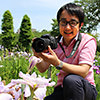The autofocus function sets the focus automatically with just a simple halfway press of the shutter button. Surprisingly, however, not many know how to utilise this feature fully. In the fifth article of the series, I will explain how we can make use of autofocus to establish focus exactly where you want it to be. (Report by: Yutaka Tanekiyo)

Pages: 1 2
Focus can only be determined at the time of the shoot
Compared to exposure and composition techniques, there is much less discussion regarding focusing and AF (autofocus). However, during the actual shoot, we would subconsciously think about where to place the focus while we are determining the composition. I am sure everyone has had the experience of failing to establish focus on the intended point or producing shots that are out of focus. Nothing can be done to correct an image if it is out of focus, so it is important to build a good foundation in photography with the proper techniques.
In this article, I will reproduce the conditions of an actual photography scene and use it to explain how we can make full use of the AF function. First of all, assuming that we want to capture the expression of a cat hiding in the bush, let's think about how we can achieve focus on the subject through the viewfinder.
1. How to capture the cat hiding in the bush?

I chanced upon a cat hiding in a bush. Aiming at its prey, the cat's expression was dynamic and very photogenic. I wanted to capture the right moment while blurring the plants in the foreground.
2. Focus was established on the bush instead in the default AF setting

I started by taking a trial shot, but the camera set the focus on the bush in the foreground instead. The AF point is automatically selected in the default AF setting, and this causes the camera to establish focus on the closest object.
3. I used the centre AF point which aligns with the cat


I changed the shooting mode of the camera to Program AE, pressed the AF point selection button at the top right corner on the rear face of the camera, and operated the cross keys to select the centre AF point. Doing so enables me to set the focus on the subject using only the AF point at the centre.
4. The camera established focus on the cat successfully!

The camera set focus automatically with only the centre AF point. I was able to establish focus on the expression of the cat in the bush instead of the plants in the foreground.
[Tip] Lock the point in focus by half-pressing the shutter button
By pressing down the shutter button halfway and holding it in this position, you can lock the focus on the subject . This can also be employed to adjust the composition, and we call this technique "AF lock". For example, after establishing the focus using only the centre AF point and holding the shutter button in the half-pressed position, you can recompose the shot by shifting the subject to another position in the image while maintaining the focus on the subject.


*Photograph is for illustration purposes. This shot is the only one where the EOS 750D was used.
By employing "AF lock", a technique to recompose a shot with the shutter button half-pressed, you can capture a shot quickly with the focus established on any position you like.
Recommended AF settings for various scenes
The key to using the AF feature is to utilise different AF settings for different scenes. For example, the settings to use when you want to adjust focus at your own pace would vary from that of when you do not want to miss out on a good photo opportunity. In the following, I will introduce the recommended shooting settings for specific scenes when you are photographing through the viewfinder.
Capturing portrait shots

One-Shot AF+Manual AF point selection
One of the key points in portrait photography is to establish focus on the face, especially the eyes. For portrait photos, which are mostly vertically oriented, it would be more convenient to align the AF point with the face in advance. As there is little movement for this type of shots, why not select One-Shot AF as the AF setting, and set the focus carefully at your own pace?
Capturing subjects with unpredictable movement, e.g., children and animals

AI Focus AF+Automatic AF point selection
To capture a subject with unpredictable movement, such as a child who is running around, it would be useful to make use of Automatic AF point selection and AI Focus AF. As long as the subject is kept within the area covered by the AF points inside the viewfinder while the shutter button is half-pressed, the camera is able to establish focus on the subject automatically. This will help to reduce the likelihood of blurred, out of focus shots.

Born in 1982 in Osaka. After graduating from the Faculty of Foreign Studies at Kyoto Sangyo University as a German language major, Tanekiyo worked as an assistant to Toshinobu Takeuchi, after which he became an independent photographer.

A monthly magazine that believes that enjoyment of photography will increase the more one learns about camera functions. It delivers news on the latest cameras and features and regularly introduces various photography techniques.
Published by Impress Corporation
































